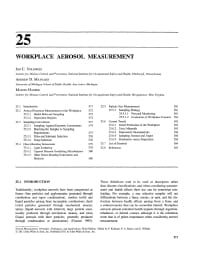Mining Publication: Workplace Aerosol Measurement
Original creation date: January 2011
Authors: JC Volkwein, AD Maynard, M Harper
NIOSHTIC2 Number: 20039343
Aerosol Measurement: Principles, Techniques, and Applications, Third Edition. Kulkarni P, Baron PA, Willeke K, eds., Hoboken, NJ: Wiley, 2011 Jan; :571-590
Traditionally, workplace aerosols have been categorized as fumes (fine particles and agglomerates generated through combustion and vapor condensation), smokes (solid and liquid particles arising from incomplete combustion), dusts (solid particles generated through mechanical means), sprays (liquid aerosols with relatively large particle sizes, usually produced through mechanical means), and mists (liquid aerosols with finer particles, generally produced through condensation or atomization) (Vincent 1995). These definitions tend to be used as descriptors rather than discrete classifications, and when considering measurement and health effects their use can be somewhat misleading. For example, a size selective sampler will not differentiate between a fume, smoke, or mist, and the distinction between health effects arising from a fume and a submicrometer dust can be somewhat blurred. Workplace aerosols present potential health impacts through ingestion, inhalation, or dermal contact, although it is the inhalation route that is of prime importance when considering aerosol measurement. Early workplace measurement (Walton and Vincent 1998) relied on particle number as the dominant metric with devices such as the koniometer (Le Roux 1970; Hewson 1996), impinger (Greenburg and Smith 1922), and thermal precipitator (Green and Watson 1935; Hamilton 1956) being used to collect samples and optical microscopy used to count numbers of particles. Although exposure to fibers is still assessed on a particle number basis, current sampling and analysis methods are dominated by the use of aerodynamic sizing of the aerosol followed by collection on filters and mass analysis (gravimetric, or by chemical analysis for specific elements or compounds). Mass is a suitable metric for assessing the dosage of systemic poisons, for example metals or pesticides, but it may be less suitable for assessing dosage for other end points. The main reason that mass is used is simply that gravimetric or chemical analysis is more accurate and more amenable to automation and instrumental analysis. Workplace aerosol measurement, while similar to other areas of aerosol measurement, differs somewhat in application and circumstance. In most cases the bulk aerosol composition is known or can be deduced from the processes or products in use. The mass concentrations involved are typically an order of magnitude greater than those in the general environment. Finally, sampling is carried out specifically for assessing human exposure, rather than characterizing the aerosol itself or the physical or chemical processes associated with it. While philosophies and approaches may differ, there is a great deal of commonality between methods used in the workplace, and those used in other areas of aerosol measurement. Thus, techniques and applications described elsewhere in this book will frequently be directly relevant to workplace sampling. Chapters 6 to 10 and 14 are particularly pertinent, providing detailed information on approaches to aerosol monitoring, filter collection, inertial, gravitational, centrifugal and thermal sampling, and direct-reading techniques. Chapters 23, 24, 26, and 27 on nonspherical particle measurement, bioaerosol measurement, ambient aerosol sampling, and aerosol exposure measurement are all relevant to the workplace. In this chapter, the emphasis is on the basic sampling philosophies and methods used on a routine basis in the workplace and the application of direct-reading monitors in workplace aerosol measurement.

NIOSHTIC2 Number: 20039343
Aerosol Measurement: Principles, Techniques, and Applications, Third Edition. Kulkarni P, Baron PA, Willeke K, eds., Hoboken, NJ: Wiley, 2011 Jan; :571-590
- Benchmarking Longwall Dust Control Technology and Practices
- Characterizing Exposures to Airborne Metals and Nanoparticle Emissions in a Refinery
- Comparing Measurements of Carbon in Diesel Exhaust Aerosols Using the Aethalometer, NIOSH Method 5040, and SMPS
- Determining the Spatial Variability of Personal Sampler Inlet Locations
- A Handheld Electrostatic Precipitator for Sampling Airborne Particles and Nanoparticles
- In-depth Survey Report: Control Technology for Environmental Enclosures - The Effect of Wind Speed Upon Aerosol Penetration Into an Enclosure at Clean Air Filter, Defiance, IA
- Portable XRF Analysis of Occupational Air Filter Samples from Different Workplaces Using Different Samplers: Final Results, Summary and Conclusions
- Rock Dusting Considerations in Underground Coal Mines
- Sonic Anemometer Airflow Monitoring Technique for Use in Underground Mines
- Use of Vacutainers for Collection of Mine Atmosphere Samples